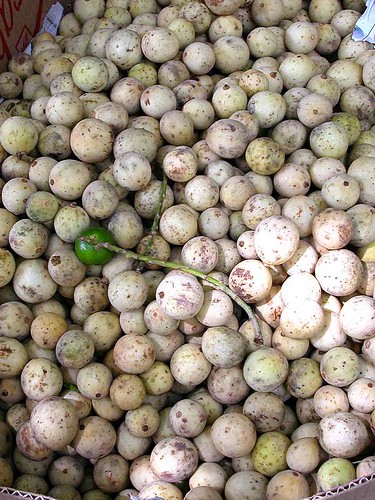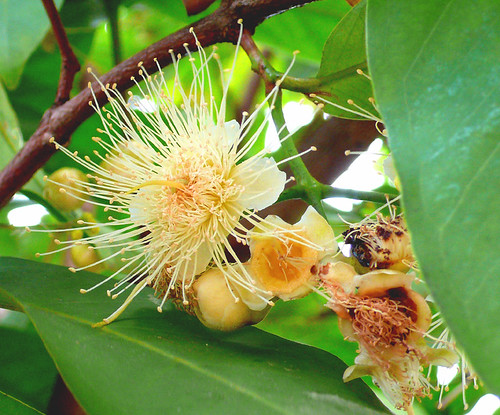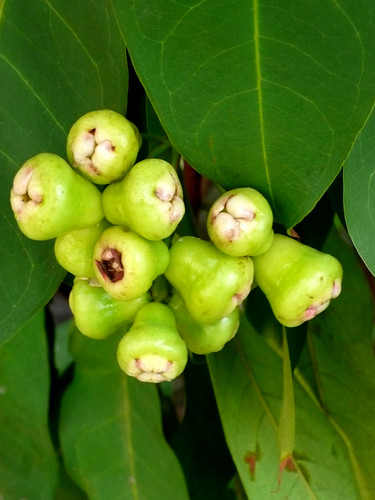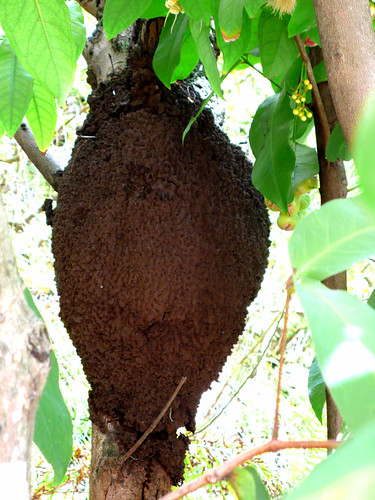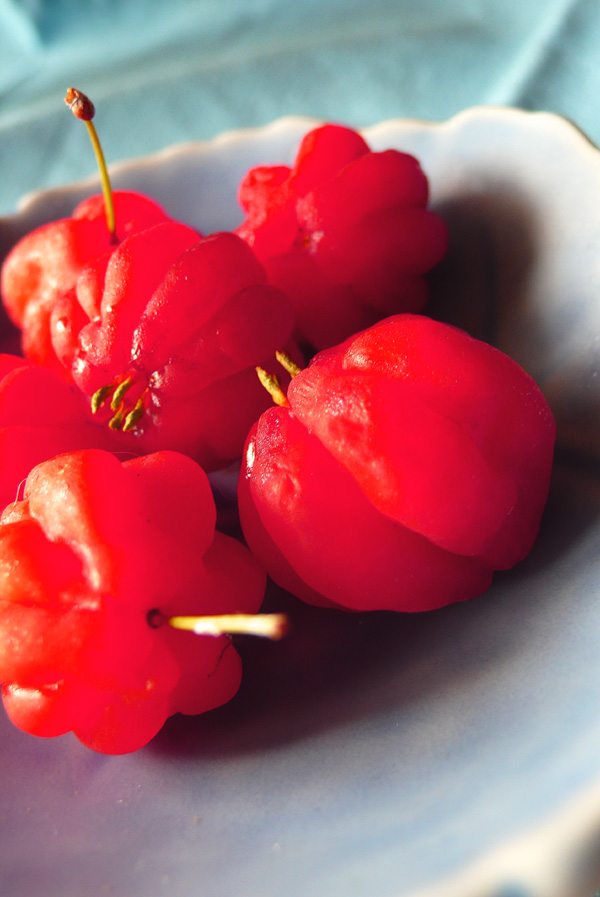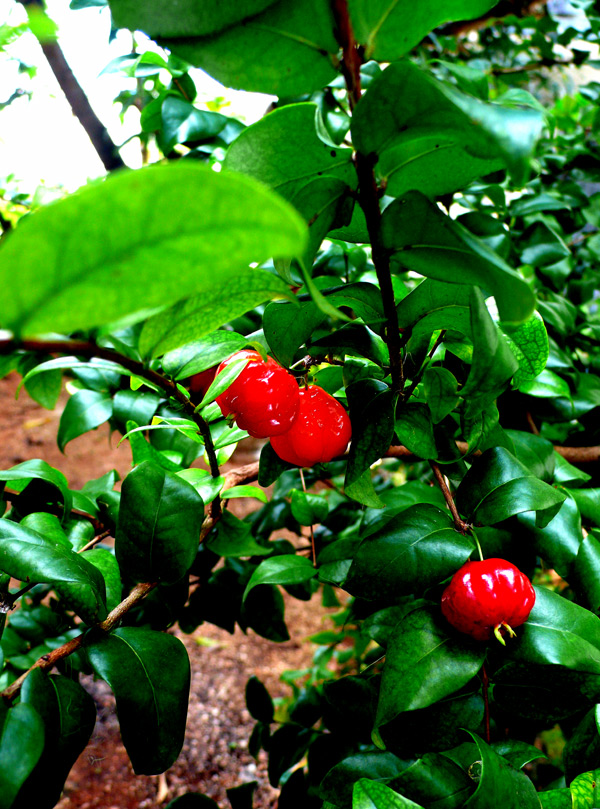this ovoid-to-round fruit is about the size of the a large concord grape, the skin is yellowy beige, which covers the opaque, segmented flesh that is mostly seedless; there can be, however, one large seed, bitter with tannins, hidden in one of the segments. the flesh itself is sweet and juicy, with a texture similar to lychees and a flavour similar, but without the florally finish. the fruit grow in grape-like bunches off of tall and lanky trees, which give off a sticky resin when the fruit is picked; the resin is thought to protect the stomach from alcohol, but is bitter and difficult to actually imbibe. the bark of the tree contains anti-inflammatory properties and thought to be an anti-spasmodic--traditional medicines made from it are used against everything from dysentery to scorpion bites. which, i don't know, could be handy where you live.
20090812
| [+/-] |
name that fruit!: lanzones. |
this ovoid-to-round fruit is about the size of the a large concord grape, the skin is yellowy beige, which covers the opaque, segmented flesh that is mostly seedless; there can be, however, one large seed, bitter with tannins, hidden in one of the segments. the flesh itself is sweet and juicy, with a texture similar to lychees and a flavour similar, but without the florally finish. the fruit grow in grape-like bunches off of tall and lanky trees, which give off a sticky resin when the fruit is picked; the resin is thought to protect the stomach from alcohol, but is bitter and difficult to actually imbibe. the bark of the tree contains anti-inflammatory properties and thought to be an anti-spasmodic--traditional medicines made from it are used against everything from dysentery to scorpion bites. which, i don't know, could be handy where you live.
20080620
| [+/-] |
a little more on macopa. |
the flower of the Syzygium samarangense.
it takes about two months for the fruit to go from bud stage to ripened fruit, although
it seems to stay at this stage for a very, very long time.
the ones on island aren't as big and juicy as this, but are a pretty shade of cherry pink.
termites love the trees, so look out for nests. not that you could miss this one.
20080525
| [+/-] |
getting a little fruity in kl. |

20071208
| [+/-] |
name that fruit!: figs. |
about a year ago, i bought a little fig tree cutting from a local growers' market. i was surprised to see it there, because i didn't think figs grew in tropical places, mainly because i never saw fresh figs in the market, nor any recipes utilizing them. the grower really didn't know anything about it, except that he had always had trees on his family's land; however, he had never actually tried the fruit, and wasn't sure if it was the same as any of the varieties sold in mainland markets or if it was some sort of asian variation.
so, i took it to my parents' house and my dad planted it in the backyard. i didn't hold much hope for it, but it grew steadily, and even managed to produce a couple of fruit sporadically over the next couple of months. i didn't really think about it much, but lately i've realized that in the past year, the tree is now over ten feet tall, and is finally yielding enough fruit to actually use in a recipe. whee! i figured it was time to actually look up what kind of fig tree it is.
 i still don't know, but found another surprise: fig trees--Ficus carica--are believed to be native to western asia, distantly related to breadfruit (Artocarpus altilis Fosb.); jackfruit (Artocarpus heterophyllus Lam.); and chinese mulberry (Cudrania tricuspidata). it is a deciduous tree that is typically ten to 30 feet in height, but can grow up to 50 feet. the branches are soft, twisty and vine-like, spreading wide rather than tall. the leaves are bright green, fuzzy, have an easily recognizable shape and grow out to nearly a foot in length. the fruit has a thin peel of varying colours (from green to dark purple), with and interior white rind holding in a mass of gelatinous seeds. they must be left to ripen on the tree, but once picked they only last for a few days.
i still don't know, but found another surprise: fig trees--Ficus carica--are believed to be native to western asia, distantly related to breadfruit (Artocarpus altilis Fosb.); jackfruit (Artocarpus heterophyllus Lam.); and chinese mulberry (Cudrania tricuspidata). it is a deciduous tree that is typically ten to 30 feet in height, but can grow up to 50 feet. the branches are soft, twisty and vine-like, spreading wide rather than tall. the leaves are bright green, fuzzy, have an easily recognizable shape and grow out to nearly a foot in length. the fruit has a thin peel of varying colours (from green to dark purple), with and interior white rind holding in a mass of gelatinous seeds. they must be left to ripen on the tree, but once picked they only last for a few days.perhaps this fragility, along with the fact that there aren't many birds on island to spread the seed are the reason why i haven't seen them before, but i'm still surprised i haven't seen it as an ingredient in asian recipes. perhaps a little more research is in order.....
20070321
| [+/-] |
name that fruit!: surinam cherry 500. |
spring has sprung on the isle, the flowers are in bloom, and the fruit is ripe on the trees--even on those that were previously thought to be barren. my parents have had this surinam cherry tree in their yard for years, i suppose a nod to their days in new jersey (in the heart of soprano-land, whee), and the giant cherry tree we had out back. however, i don't think this one ever fruited until now.
the surinam cherry--eugenia flora L. to her friends--was one of those many plants brought over to the islands by the portuguese explorers, most likely from goa, maybe by way of south america, as it is sometimes known as brazilian cherry. i believe the chamoru/local name for this is pitanga (although it's usually just called "cherry" pffft), but i can't seem to find the tagalog/filipino name for it, as it does not seem to be common in the philippines. certainly, it's not so common here that everyone knows what it is, but if someone had one in their backyard they remember the fruit, which is bright orangey red when young and a deep sanguine red when ripe, thin-skinned, and juicy, with a core of tiny resinous yellowish-white seeds in the middle when immature, which rather miraculously becomes a recognizable pit upon ripening. a very attractive fruit; surely if this was in the garden of eden, we might be in less trouble today. the flesh is similar to that of the more commonly known cherry, but the flavour is not; frankly, even after eating more than a handful of these, i'm not sure exactly what the flavour is. it it vaguely reminiscent of cherry, but only because its skin is a bit tart but the rest is mellow sweet. it almost tastes like a bell pepper to me, but with a different finish--not so much bitter and spicy, but tart and slightly tomatoey. the fruit is best left to ripen on the tree, when a mere touch will bring them down. supposedly a sprinkle of sugar will intensify the flavour, and make a good substitute for strawberries. my friend bill makes these into a brilliant jam, i'm told. i'll have to ask him for the recipe, once this tree comes to full fruition.
20061020
| [+/-] |
name that fruit!: rambutan. |

a bonus name that fruit!: rambutan, nephelium lappaceum, a native of the southeast asia region that is related to the lychee (litchi), longan, and guarana. it looks like a takashi murakami vision realized: bright red, with chartreuse spikes, encasing an opaque eyeball with a black pupil of a seed. the name, rambutan, comes from the malay word for "hairy" which of course refers to its little fuzzy spikes. it, however, is not prickly nor sharp, but instead not unlike latex toy that...whoops. i just realized what it's just like, and i can't tell you, it was passed around at a recent bridal shower i attended. anyway, the spiky rind is latex bendy and once cracked through, the fruit is similar to the lychee in appearance--somewhat opaque flesh surrounding a large black drupe/seed, with a sweet, sticky juice--and similar in flavour, but not quite as delicate. well, with an exterior like that, would you be?
20061018
| [+/-] |
name that fruit!: atemoya. |

sometimes i feel like i could be perfectly happy not ever eating another washington apple nor california grape again, as long as i had an abundance of tropical fruit available. sometimes, especially when i see the variety available in the markets and shops in the philippines. i am a little sad to see that more tropical fruit is being imported in from malaysia and thailand at a cheaper price than the local crops, and while i appreciate the availability, i hope local farmers do not suffer because of the competition.


i haven't really taken the time to figure out what fruits are in season each month, and i most certainly haven't tried all the different kinds. however, i do try to taste a fruit unfamiliar to me every time i go.
this time around i tried an atemoya, a hybrid between a sweetsop, otherwise known as atis (annona squamosa), and cherimoya (annona cherimola). both are members of the same family of fruit, annonas, and all the fruit are similar in colouring--a pale green, lightly textured thin skin covers milky white flesh flecked with large black seeds. the flavour is milky, sweet, and very delicately tart. 
the only difference that i can discern between this and atis is that the bulby protuberances are a bit spikier, and the fruit seem capable of growing larger. the flesh a little denser, and somewhat "fruitier" in taste, with a bit of a latex-like aftertaste. almost as if it was a cross between atis and a piece of juicyfruit gum. not really a good selling point, but maybe intriguing enough for you to try one.
20060313
| [+/-] |
name that fruit!: you say star apples, star fruit, i say huh? |

this edition of "name that fruit!" should rightfully be called "name those fruits" as you can see there are actually two here. durrrr. however, both have been referred to as "star fruit" or "star apples" to me as both have star patterns of sorts when cut through. i grew up not really knowing what was called what in english, and still never get it straight. of course, this confusion is easily sorted by just referring to them by their latin names, but who really does that, ever. "johnny, i'd like you to meet my favourite passionfruit, just call him ricardo."
let's start with the simpler one, that being the oblong, angular yellowish fruit, from the Averrhoa carambola tree. in english it is named the carambola, but colloquially known as starfruit because when sliced through, the star shape is more than evident. i rather do prefer 'carambola', as it's more like an epithet than a name (¡ay, carambola!), but perhaps its constitution doesn't really deserve that. it is crunchy, cellulosy, sweet, and juicy, with a taste and texture reminiscent of an asian pear, but somewhat more delicately so, yet with a more astringent bite (in fact, it is related to the distinctly sour camias). another name for it is the coromandel gooseberry, which is a mouthful, but perhaps matches its ornamental beauty and oddity best.
the round, greeny fruit with the white flesh is Chrysophyllum cainito, and interestingly, the only english names i could find for it were both confusing. it is either known as a star apple--as is the carambola--or custard apple, which annona, cherimoya, and sweetsop are called as well. wtf? surely these fruits, while similar, are different enough to come up with more than one name for them; after all, a raspberry is a raspberry and a blackberry is not (although, come to think of it, sometimes a blackberry is a mulberry, a marionberry, or a crutch of a device for internet addicts the world over....). the star pattern is vaguely detectable in the seed pattern (frankly, i think "star fruit" as a description is pushing it a little).it is fleshy, exceptionally sweet, milky, and sort of unsettlingly creamy; in fact, when i was younger my mother used to refer to this as ice-cream fruit. not that it ever fooled me.
but it did stick with me. armed with this notion, and a few galletas-- an arrowroot-based (? i have no idea.) sweet wafer from the philippines--and a lot of time on my hands, i decided to try to make star apple ice cream. i didn't want to overwhelm the delicate flavour of the fruit, so i just add full-fat milk and some sugar syrup to the de-seeded pulp, and froze the lot. after running it through the blender a few times (of course you can use an ice cream machine), i had a credible sherbet on my hands. the only problem is that the star apple really tastes most like sweet milk anyway; i couldn't tell if i just overwhelmed the flavour altogether, or if it was a successful run. the texture was not quite of ice cream, however; the pulp made it icier, and ever-so- slightly gummy. no matter. it was quite lovely, sandwiched between two galletas, and served with slices of starfruit for contrast.
20050902
| [+/-] |
name that fruit!: atis |

we have a lot of atis trees in pampanga. atis--latin name: annona squamosa, aka custard apple, sugar apple, or sweetsop--is the most widely grown of the annona varieties, which include the well-known cherimoya. its origins are unknown, but the spaniards most likely brought from south america and introduced it to southeast asia sometime before 1590.
the fruit is usually 2-4 inches (6-10 cm) long. it is covered in a dull greenish rind and is composed of knobby segments, which break apart easily when ripe. the pink-around-the-edges creamy white flesh surrounds dark, glossy inedible seeds. the soft, scoopable flesh is often compared to a sweet custard in texture and taste, and is best eaten fully ripe and fresh; however, freezing the fruit will yield an instant, portable, creamy, fruity 'sherbet' that is most welcome on hot summer days.
20050528
| [+/-] |
name that fruit!: the mighty mangosteen |
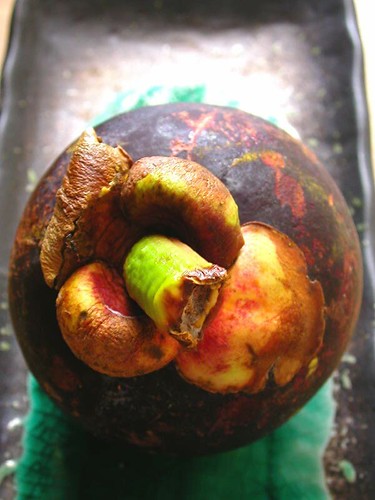
quite possibly my favourite fruit, ever: mangosteen, garcinia mangostana, from the family guttiferae. its origins have been traced to the malaccas and malaya, and is found throughout southeast asia, but very rarely outside of it. it has been planted with some success in the southern reaches of india, and in the west indies and central america, but attempts to cultivate it in the other americas, africa, and europe have been less than successful. so this, my dear tsogb readers in north america and europe, could possibly be the best fruit you'll never eat.
it is a notoriously picky tree, difficult to grow, temperamental, and the fruit does not travel well. a diva, if you will. however, the mangosteen is a jewel, indeed--a smooth, round ball of deep purple-red to purple black, capped by a citrine calyx and a chartreuse stem. the outer "husk" is smooth and hard, but when ripe, a little light pressure will force it open. if the fruit is unripe or overripe, it is it nearly impossible to open the fruit--it becomes as hard as a rock, and even a good sawing or hard swing of a baseball bat has known to be futile. once inside, though, it reveals the creamy, opaque ivory white segments within, surrounded by a reddish-purpley rind that oozes an acidic yellow latex and a juice that will stain anything it touches horrendously. there are anywhere from four to eight segments in each fruit, the largest one(s) containing a seed, which is only viable for planting within 48 hours of uncovering it. 
so what does this elusive fruit taste like? i find that the flavour is reminiscent of every fruit you've ever eaten--a little like peach, strawberry, banana, mango, pineapple, pear, lychee, etcetera--and yet completely indescribable. heat and time destroy the flavour so it's impossible to taste a true mangosteen flavour from canned, dried, or bottled fruit or juice. it is sweet, tempered by a touch of sourness, it is bold, yet completely delicate. is it worth the trouble of planting, obtaining, opening, the acidic latex, and the staining juice? sweet sarah jessica parker! why yes, yes, a thousand times yes! it is.
as it is completely banned from import into the united states and next to impossible to import anywhere else, i suggest anyone interested in trying this lovely gem to take a holiday anywhere mangosteen can be found, from now until september, whilst they are in season. and if you are lucky enough to find the limited edition häagen-dazs mangosteen sorbet, then good goddess, you better contact me, pronto!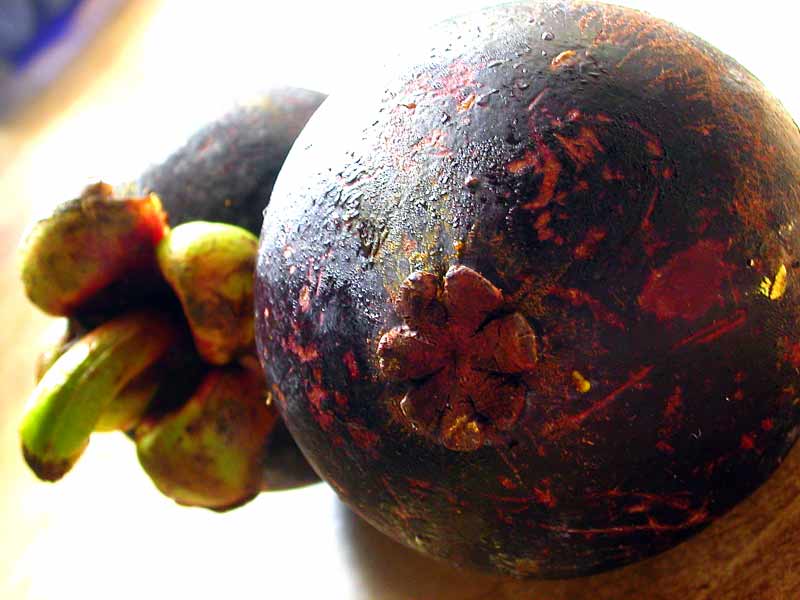
fun fact: the number of points on the little flowery star on the bottom of the fruit will tell you how many segments are inside
further reading: market manila's excellent post on this delicious fruit.
20041009
| [+/-] |
bfmp 2: name that fruit! |

A LOT of people come to this blog because they google this fruit. what is it?
20040913
| [+/-] |
name that fruit!: dayap |

citrus aurantiifolia (christm. et panz.) swingle (?!), dayap, or native lime. in the philippines that is. sometimes called a mexican lime, west indian lime or key lime. it can be used any way a lime can, or even be a substitute for lemon.
i know the absolute easiest way to juice any citrus fruit is to microwave it for 20-30 seconds (to release the juice), cool it, cut in half, then stick a fork in it and twist, but i love my little lime juicer i picked up in los angeles at the farmer's market, one of my most favourite places in the world. if you ever go, stop by bennett's ice cream stand. not only are all the ice creams, sorbets, and frozen yogurts homemade, they have freshly made lemonade and limeade. one of my secret la tips: order the limeade with carbonated water--it's fresh, not too tart, not too sweet, and an absolute quencher on a hot summer's day. also, it's not on the menu; you'll be tipped as an old school los angeleno, rare to find these days.

20040806
| [+/-] |
name that fruit!: camias |

i tried to find an english name for this fruit, known as a camias (kamyas, kamias)--pronounced kahmyás--but couldn't. a relative of the carambola, it is believed to have originated in sri lanka, but it is cultivated and grows wild throughout southeast asia. the latin name for the tree itself is averrhoa bilimbi, but it is the carambola that is known in the philippines as the bilimbing, in malaysia as the belimbing, and on guam as the bilimbines. the tree, in english, is called a tropical cucumber tree, but the fruit is not considered a tropical cucumber. meh. whatever.
the camias is similar in texture and taste to the carambola, but its high oxalic acid content often makes it too acidic or sour to eat raw, although it is often used as a component in a raw salsa. it is made into pickles, preserves and candies, or added to curries or to soups as a souring agent. when i am loathe to leave the house, i go out to our tree and chop up a large quantity of fruit, sautée it with onions and garlic, and serve it with grilled or broiled salmon. the acids reduce dramatically in cooking, and it mellows out to a nice lemony pear flavour. excellent.
camias are so acidic, they are used to clean the blades of daggers, bleach stains off of skin, or take the tarnish off of brass (cheap oxy clean, anyone?) . the leaves are boiled for a cough remedy, and a flower infusion is said to be effective against fever and er, thrush.

20040607
| [+/-] |
get that thing away from me (or, name that fruit!, pt.2) |

freshly caught langka
this is my cousin jay. no, not the big bilious green thing, but the guy holding up the big bilious green thing. the big bilious green thing is langka--otherwise known as a jackfruit. a relative of the breadfruit, it originated in the ghats of india, and quickly spread throughout southeast asia, and the pacific. it is not related to the durian, which i kinda find hard to believe, as both are highly fragrant giant stinkin' things. although the jackfruit is more of a sweet, flowery stink as opposed to the rotting garbage stink of the durian.
a jackfruit can grow up to 80 pounds and 36 inches in length. the flesh of the jackfruit is pale to dark yellow, wrapped around brown ovoid seeds, and has a sort of sweet apple-banana-y taste with a jasmine finish. it's used in desserts, stewed, fried, baked and boiled. i have no use for it, which is why the specimen pictured is with jay and not on our kitchen table.
if you need some jackfruit, go to seaside mart and jay will sell a chunk to you.
20040603
| [+/-] |
name that fruit! |
One of my favourite fruits is siniguelas (don't know if this is both singular and plural), which is how it's known in the philippines, and known in america as um...uh...foreign. most english names for it are variations on a plum: spanish plum, jamaican plum, hog plum (!)...but it is also called "hoy", which, if you are in any way flipeeno, you have probably been called once or twice before....

hoy! siniguelas!
native to the more tropical regions of the americas, it is related to the mango and the cashew, and it was brought to the philippines and the marianas by spanish colonists. the fruit is oval-ish, 1 to 2 inches in length, green at first but ripens to a lovely reddy purply colour with greeny streaks. the flesh inside is similar in taste and colour to a mango--sweet, slightly acidic-- and the large seed can be cracked open and eaten (although i don't know anyone who bothers).
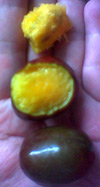
devolved, devoured.
deeeeelish.

